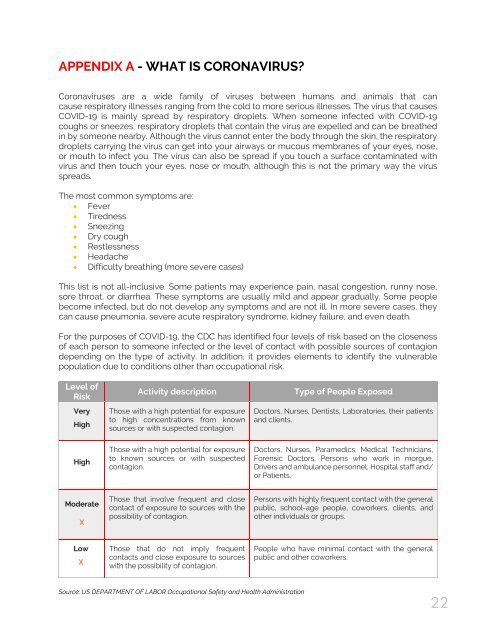CPS Roadmap to Reopening
Create successful ePaper yourself
Turn your PDF publications into a flip-book with our unique Google optimized e-Paper software.
APPENDIX A - WHAT IS CORONAVIRUS?<br />
Coronaviruses are a wide family of viruses between humans and animals that can<br />
cause respira<strong>to</strong>ry illnesses ranging from the cold <strong>to</strong> more serious illnesses. The virus that causes<br />
COVID-19 is mainly spread by respira<strong>to</strong>ry droplets. When someone infected with COVID-19<br />
coughs or sneezes, respira<strong>to</strong>ry droplets that contain the virus are expelled and can be breathed<br />
in by someone nearby. Although the virus cannot enter the body through the skin, the respira<strong>to</strong>ry<br />
droplets carrying the virus can get in<strong>to</strong> your airways or mucous membranes of your eyes, nose,<br />
or mouth <strong>to</strong> infect you. The virus can also be spread if you <strong>to</strong>uch a surface contaminated with<br />
virus and then <strong>to</strong>uch your eyes, nose or mouth, although this is not the primary way the virus<br />
spreads.<br />
The most common symp<strong>to</strong>ms are:<br />
• Fever<br />
• Tiredness<br />
• Sneezing<br />
• Dry cough<br />
• Restlessness<br />
• Headache<br />
• Difficulty breathing (more severe cases)<br />
This list is not all-inclusive. Some patients may experience pain, nasal congestion, runny nose,<br />
sore throat, or diarrhea. These symp<strong>to</strong>ms are usually mild and appear gradually. Some people<br />
become infected, but do not develop any symp<strong>to</strong>ms and are not ill. In more severe cases, they<br />
can cause pneumonia, severe acute respira<strong>to</strong>ry syndrome, kidney failure, and even death.<br />
For the purposes of COVID-19, the CDC has identified four levels of risk based on the closeness<br />
of each person <strong>to</strong> someone infected or the level of contact with possible sources of contagion<br />
depending on the type of activity. In addition, it provides elements <strong>to</strong> identify the vulnerable<br />
population due <strong>to</strong> conditions other than occupational risk.<br />
Level of<br />
Risk<br />
Very<br />
High<br />
Activity description<br />
Those with a high potential for exposure<br />
<strong>to</strong> high concentrations from known<br />
sources or with suspected contagion.<br />
Type of People Exposed<br />
Doc<strong>to</strong>rs, Nurses, Dentists, Labora<strong>to</strong>ries, their patients<br />
and clients.<br />
High<br />
Those with a high potential for exposure<br />
<strong>to</strong> known sources or with suspected<br />
contagion.<br />
Doc<strong>to</strong>rs, Nurses, Paramedics, Medical Technicians,<br />
Forensic Doc<strong>to</strong>rs, Persons who work in morgue,<br />
Drivers and ambulance personnel, Hospital staff and/<br />
or Patients.<br />
Moderate<br />
X<br />
Those that involve frequent and close<br />
contact of exposure <strong>to</strong> sources with the<br />
possibility of contagion.<br />
Persons with highly frequent contact with the general<br />
public, school-age people, coworkers, clients, and<br />
other individuals or groups.<br />
Low<br />
X<br />
Those that do not imply frequent<br />
contacts and close exposure <strong>to</strong> sources<br />
with the possibility of contagion.<br />
People who have minimal contact with the general<br />
public and other coworkers.<br />
Source: US DEPARTMENT OF LABOR Occupational Safety and Health Administration<br />
22








